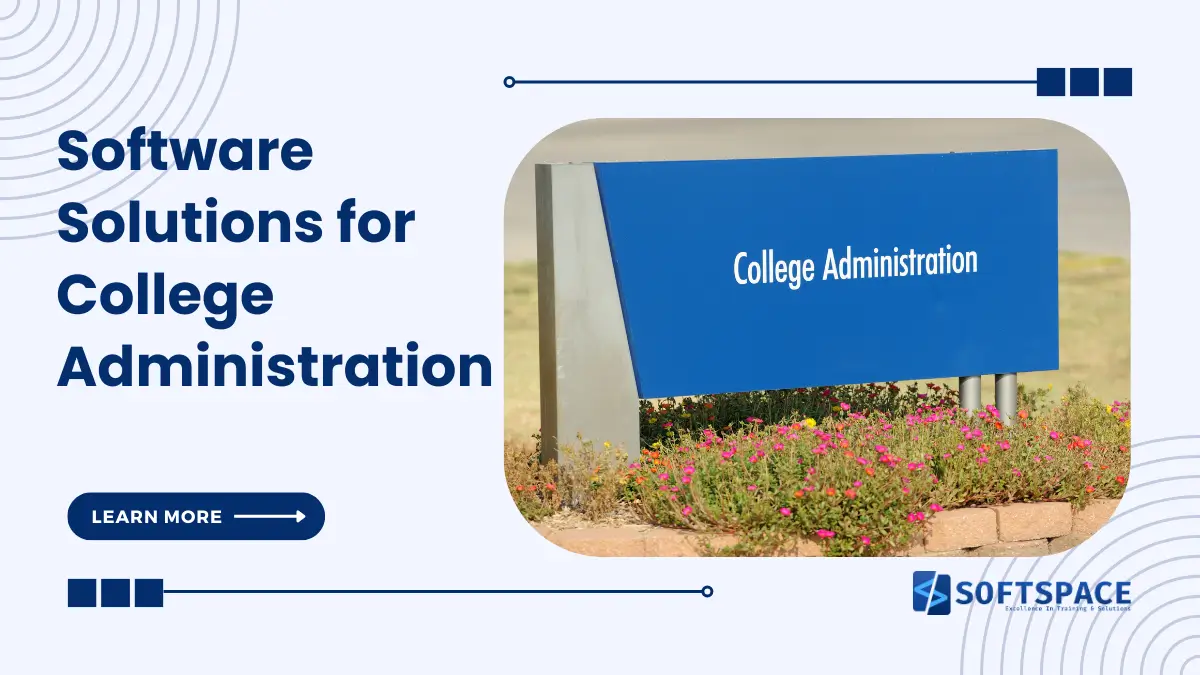Today’s college administrations face many challenges that require creative solutions. Dive into the world of advanced software that revolutionizes various processes, from welcoming new employees to maintaining connections with former students. Discover the cutting-edge tools transforming college administration, streamlining processes, and boosting efficiency. Find out how the Software Solutions for College Administrations, allow more time and resources to enhance the student experience.
Key Takeaways For Innovative Software Solutions for College Administrations
- Digital transformation: Colleges must adopt digital technologies to remain competitive and efficient. This involves moving from paper-based systems to digital platforms for all administrative processes.
- Cloud-based systems: These allow access to data and applications from anywhere, anytime. Cloud solutions also offer better scalability and reduce the need for on-premises infrastructure.
- Data analytics tools: These help administrators make informed decisions based on real-time data. They can identify trends, predict outcomes, and optimize resource allocation.
- Automated processes: Automation reduces manual work, minimizes errors, and speeds up administrative tasks. This frees up staff time for more complex, value-added activities.
- Integrated platforms: These connect different departments and systems, allowing for seamless data flow and collaboration. Integrated solutions eliminate data silos and improve overall efficiency.
- Mobile applications: Apps provide students with on-the-go access to important information and services. They enhance engagement by meeting students where they are – on their smartphones.
- AI-powered chatbots: These provide instant responses to common queries, reducing the workload on administrative staff. Chatbots can handle a wide range of tasks, from answering FAQs to guiding students through processes.
- Cybersecurity measures: Robust security protocols protect sensitive student and institutional data from breaches. This is crucial as colleges handle vast amounts of personal and financial information.
- Personalized learning platforms: These use data to tailor educational experiences to individual student needs. They can help improve retention rates and academic outcomes.
- Regular software updates: Keeping software current ensures compliance with changing regulations and security standards. It also provides access to new features and improvements.
Revolutionizing Admissions with AI-Driven Software
Revolutionizing admissions, AI-driven software is changing the way colleges process applications. By automating the initial screening and accurate analysis of candidate data, these tools simplify the selection process, making it faster and more efficient. Institutions can now focus on finding the best fit for their programs while AI handles repetitive tasks.
For students navigating this process, Customwritings.com offers invaluable support with essays and other assignments, ensuring that applications stand out in the competitive field. This AI integration not only speeds up admissions but also improves the overall experience for both colleges and applicants.
Streamlining Student Records Management
Managing student statistics effectively is crucial for any university, and contemporary software is making it less complicated than ever. Advanced systems now automate the garage, retrieval, and updating of scholar records, reducing administrative burdens and minimizing mistakes. These tools permit real-time access to facts, simplifying responsibilities like registration, grading, and tracking academic progress.
With secure cloud storage, establishments ensure that facts are covered while remaining handed to authorized personnel. This streamlined approach frees up staff time to focus on supporting student achievement and enhancing educational impact.
Enhancing Communication with Integrated Platforms
Effective communication is the foundation of a thriving academic environment. Integrated platforms revolutionize how colleges interact with students, faculty, and staff. These systems combine emails, messages, and alerts into one streamlined interface that ensures prompt and efficient delivery of critical information.
Features like automatic reminders, real-time updates, and centralized communication hubs improve campus collaboration and engagement. By breaking down communication barriers, these platforms foster a more connected and responsive community, increasing overall satisfaction and ensuring that everyone stays informed and engaged in the learning process.
Boosting Efficiency in Financial Administration
Administering the university budget may be complex and time-consuming. Yet, modern software solutions substantially grow efficiency in this location, as such equipment automates duties, which include budgeting, invoicing, and monetary reporting, reducing the danger of errors and saving valuable time.
Advanced analytics provide the perception of spending patterns and monetary health, helping establishments make knowledgeable decisions. Streamlined tuition series and economic aid control techniques additionally enhance the student’s enjoyment by making it less difficult to music and manipulate bills. By leveraging those innovations, colleges can enhance their economic operations and attention more to their instructional task.
Optimizing Campus Operations through Automation
Campus automation can improve the efficiency of college facilities management. Modern software solutions offer some tools designed to optimize routine tasks and optimize the allocation of resources. For example, automated scheduling systems make it easier to reserve classrooms and meeting spaces, ensuring optimal use of campus resources. The maintenance management software program tracks facility issues and schedules repairs ahead of time, reducing downtime and improving campus conditions.
Energy control systems music and control power use, helping groups lessen prices and assist sustainability projects. In addition, campus security structures provide actual-time alerts and simplify emergency response. By integrating this automation equipment, faculties can improve operational efficiency, reduce administrative burden, and create a greater responsive and properly controlled campus environment, presenting a better experience for college students, schools, and staff.
Elevating Alumni Engagement with Innovative Tools
Engaging alumni efficiently is crucial for retaining strong relationships and fostering endured aid for schools. Innovative tools are reshaping how establishments hook up with their alumni networks. Personalized communication structures permit faculties to send focused updates, event invitations, and newsletters, keeping alumni informed and concerned. Virtual event platforms facilitate online reunions, webinars, and networking occasions, making it simpler for alumni to take part no matter their place.
Advanced CRM systems assist and manipulate alumni interactions, providing insights into alternatives and engagement degrees. Social media integration similarly extends outreach and encourages alumni to stay related. By leveraging such tools, faculties can build vibrant alumni communities, decorate engagement, and domesticate long-time period guides, ultimately strengthening their institutional effect and fostering a sense of belonging amongst former students.
Enhancing Campus Security through Smart Technology
Enhancing campus security through smart technology is a game-changer for modern colleges. Intelligent surveillance systems equipped with AI analyze real-time photos, detecting uncommon activities and alerting safety personnel at once. Access control systems use biometric records to ensure that only authorized individuals enter confined areas.
Emergency reaction apps permit immediate conversation between college students and campus protection, imparting rapid help in essential situations. Additionally, clever lighting and environmental sensors contribute to a safer campus, using enhancing visibility and detecting potential risks. These technologies collectively create a more stable environment and defend college students, workers, and campus assets at the same time as selling peace of mind.
Examples of Software Solutions for College Administrations
- Student Information Systems (SIS): Examples include Ellucian Banner, Workday Student, and PeopleSoft Campus Solutions. These manage student records, course registration, and academic progress.
- Learning Management Systems (LMS): Popular options are Canvas, Blackboard, and Moodle. These platforms facilitate online learning, course content delivery, and student-teacher interactions.
- Customer Relationship Management (CRM) systems: Salesforce Education Cloud and Slate are widely used. They help manage relationships with prospective students, alumni, and donors.
- Enterprise Resource Planning (ERP) systems: Oracle Cloud ERP and SAP S/4HANA are examples. These integrate various administrative functions like finance, HR, and procurement.
- Data Analytics and Business Intelligence tools: Tableau, Power BI, and SAS are commonly used for data visualization and analysis in higher education.
Conclusion
In conclusion, embracing innovative software solutions is no longer optional for college administrations—it’s a necessity in today’s fast-paced, technology-driven educational landscape. By implementing software solutions for college administrations as a cutting-edge system for student information management, financial aid processing, and data analytics, institutions can streamline operations, enhance decision-making, and ultimately provide a better experience for students and staff alike.
As we look to the future, the colleges that thrive will be those that leverage these technological advancements to create more efficient, responsive, and student-centered environments. The time to innovate is now.

13+ Yrs Experienced Career Counsellor & Skill Development Trainer | Educator | Digital & Content Strategist. Helping freshers and graduates make sound career choices through practical consultation. Guest faculty and Digital Marketing trainer working on building a skill development brand in Softspace Solutions. A passionate writer in core technical topics related to career growth.


